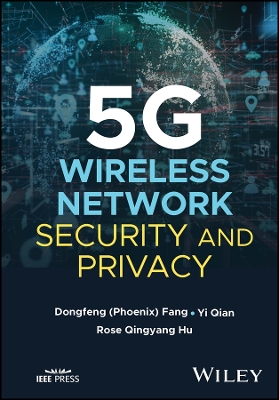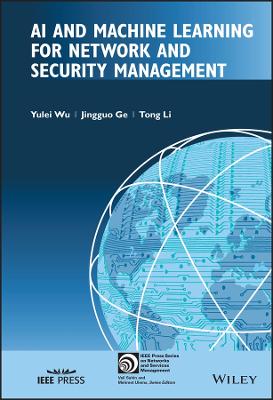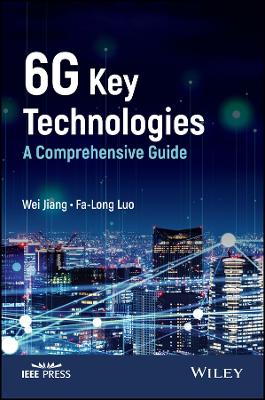5G Wireless Network Security and Privacy
 -15%
portes grátis
-15%
portes grátis
5G Wireless Network Security and Privacy
Hu, Rose Qingyang; Qian, Yi; Fang, DongFeng
John Wiley & Sons Inc
12/2023
250
Dura
Inglês
9781119784296
15 a 20 dias
Descrição não disponível.
About the Authors ix
Preface xi
Acknowledgments xiii
Introduction xv
1 Introduction to 5G Wireless Systems 1
1.1 Motivations and Objectives of 5G Wireless Networks 1
1.2 Security Drives and Requirements 2
1.3 5GWireless Network Architecture 4
1.3.1 Overview of the 5G Wireless Network Architecture 4
1.3.2 Comparison Between the Legacy Cellular Network and the 5GWireless Network 5
1.4 Conclusion 6
2 Security from Legacy Wireless Systems to 5G Networks 7
2.1 Network Security for Legacy Systems 7
2.2 Security Attacks and Security Services in 5G Wireless Networks 9
2.2.1 Security Attacks 9
2.2.2 Security Services 11
2.2.2.1 Authentication 12
2.2.2.2 Confidentiality 12
2.2.2.3 Availability 13
2.2.2.4 Integrity 14
2.3 The Evolution of Wireless Security Architectures from 3G to 5G 14
2.3.1 3G Security Architecture 14
2.3.2 4G Security Architecture 15
2.3.3 5GWireless Security Architecture 16
2.3.3.1 Overview of the Proposed 5G Wireless Security Architecture 16
2.3.3.2 Security Domains 17
2.4 Summary 18
3 Security Services and Mechanisms in 5G Wireless Systems 19
3.1 Cryptographic Approaches and Physical Layer Security 19
3.2 Authentication 22
3.3 Availability 27
3.4 Data Confidentiality 29
3.5 Key Management 33
3.6 Privacy 35
3.7 Conclusion 36
4 An Efficient Security Solution Based on Physical Layer Security in 5G Wireless Networks 37
4.1 Enhancing 5G Security Through Artificial Noise and Interference Utilization 37
4.2 A HetNet System Model and Security Analysis 38
4.2.1 System Model and Threat Model 38
4.2.2 Security Analysis 40
4.3 Problem Formulation and Analysis 42
4.3.1 Maximum Secrecy Rate 43
4.3.2 The Proposed Algorithm 43
4.4 Numerical and Simulation Results 46
4.5 Conclusion 49
5 Flexible and Efficient Security Schemes for IoT Applications in 5G Wireless Systems 51
5.1 IoT Application Models and Current Security Challenges 51
5.2 A General System Model for IoT Applications Over 5G 52
5.2.1 System Architecture 52
5.2.2 Trust Models 54
5.2.3 Threat Models and Design Objectives 55
5.3 The 5G Authentication and Secure Data Transmission Scheme 56
5.3.1 Overview of the 5G Authentication and Secure Data Transmission Scheme 56
5.3.2 The Detailed Scheme 57
5.3.2.1 Phase 1 -- System Initialization 57
5.3.2.2 Phase 2 -- Authentication and Initial Session Key Agreement 58
5.3.2.3 Phase 3 -- Data Transmission 58
5.3.2.4 Phase 4 -- Data Receiving 59
5.3.2.5 Phase 5 -- T2 IoT Devices Authentication and Initial Session Key Agreement 59
5.4 Security Analysis 60
5.4.1 Protocol Verification 61
5.4.2 Security Objectives 61
5.4.2.1 Mutual Authentication 61
5.4.2.2 Initial Session Key Agreement 62
5.4.2.3 Data Confidentiality and Integrity 62
5.4.2.4 Contextual Privacy 62
5.4.2.5 Forward Security 62
5.4.2.6 End-to-End Security 63
5.4.2.7 Key Escrow Resilience 63
5.5 Performance Evaluation 63
5.5.1 Security Services 63
5.5.2 Computational Overhead 63
5.5.3 Communication Overhead 66
5.6 Conclusion 67
6 Secure and Efficient Mobility Management in 5G Wireless Networks 71
6.1 Handover Issues and Requirements Over 5G Wireless Networks 71
6.2 A 5G CN Model and HetNet System Model 72
6.3 5G Handover Scenarios and Procedures 75
6.3.1 Handover Scenarios 75
6.3.2 Handover Procedures 76
6.4 A New Authentication Protocol for 5G Networks 79
6.4.1 Assumptions 80
6.4.2 Pre-Authentication 80
6.4.3 Full Authentication 81
6.4.4 Fast Authentication 83
6.4.4.1 Handover Between APs 83
6.4.4.2 Handover Between BSs 84
6.5 Security Analysis of the New 5G Authentication Protocols 84
6.6 Performance Evaluations 85
6.6.1 Communication Overhead 86
6.6.2 Computation Overhead 86
6.7 Conclusion 87
7 Open Issues and Future Research Directions for Security and Privacy in 5G Networks 89
7.1 New Trust Models 89
7.2 New Security Attack Models 90
7.3 Privacy Protection 90
7.4 Unified Security Management 91
References 93
Index 103
Preface xi
Acknowledgments xiii
Introduction xv
1 Introduction to 5G Wireless Systems 1
1.1 Motivations and Objectives of 5G Wireless Networks 1
1.2 Security Drives and Requirements 2
1.3 5GWireless Network Architecture 4
1.3.1 Overview of the 5G Wireless Network Architecture 4
1.3.2 Comparison Between the Legacy Cellular Network and the 5GWireless Network 5
1.4 Conclusion 6
2 Security from Legacy Wireless Systems to 5G Networks 7
2.1 Network Security for Legacy Systems 7
2.2 Security Attacks and Security Services in 5G Wireless Networks 9
2.2.1 Security Attacks 9
2.2.2 Security Services 11
2.2.2.1 Authentication 12
2.2.2.2 Confidentiality 12
2.2.2.3 Availability 13
2.2.2.4 Integrity 14
2.3 The Evolution of Wireless Security Architectures from 3G to 5G 14
2.3.1 3G Security Architecture 14
2.3.2 4G Security Architecture 15
2.3.3 5GWireless Security Architecture 16
2.3.3.1 Overview of the Proposed 5G Wireless Security Architecture 16
2.3.3.2 Security Domains 17
2.4 Summary 18
3 Security Services and Mechanisms in 5G Wireless Systems 19
3.1 Cryptographic Approaches and Physical Layer Security 19
3.2 Authentication 22
3.3 Availability 27
3.4 Data Confidentiality 29
3.5 Key Management 33
3.6 Privacy 35
3.7 Conclusion 36
4 An Efficient Security Solution Based on Physical Layer Security in 5G Wireless Networks 37
4.1 Enhancing 5G Security Through Artificial Noise and Interference Utilization 37
4.2 A HetNet System Model and Security Analysis 38
4.2.1 System Model and Threat Model 38
4.2.2 Security Analysis 40
4.3 Problem Formulation and Analysis 42
4.3.1 Maximum Secrecy Rate 43
4.3.2 The Proposed Algorithm 43
4.4 Numerical and Simulation Results 46
4.5 Conclusion 49
5 Flexible and Efficient Security Schemes for IoT Applications in 5G Wireless Systems 51
5.1 IoT Application Models and Current Security Challenges 51
5.2 A General System Model for IoT Applications Over 5G 52
5.2.1 System Architecture 52
5.2.2 Trust Models 54
5.2.3 Threat Models and Design Objectives 55
5.3 The 5G Authentication and Secure Data Transmission Scheme 56
5.3.1 Overview of the 5G Authentication and Secure Data Transmission Scheme 56
5.3.2 The Detailed Scheme 57
5.3.2.1 Phase 1 -- System Initialization 57
5.3.2.2 Phase 2 -- Authentication and Initial Session Key Agreement 58
5.3.2.3 Phase 3 -- Data Transmission 58
5.3.2.4 Phase 4 -- Data Receiving 59
5.3.2.5 Phase 5 -- T2 IoT Devices Authentication and Initial Session Key Agreement 59
5.4 Security Analysis 60
5.4.1 Protocol Verification 61
5.4.2 Security Objectives 61
5.4.2.1 Mutual Authentication 61
5.4.2.2 Initial Session Key Agreement 62
5.4.2.3 Data Confidentiality and Integrity 62
5.4.2.4 Contextual Privacy 62
5.4.2.5 Forward Security 62
5.4.2.6 End-to-End Security 63
5.4.2.7 Key Escrow Resilience 63
5.5 Performance Evaluation 63
5.5.1 Security Services 63
5.5.2 Computational Overhead 63
5.5.3 Communication Overhead 66
5.6 Conclusion 67
6 Secure and Efficient Mobility Management in 5G Wireless Networks 71
6.1 Handover Issues and Requirements Over 5G Wireless Networks 71
6.2 A 5G CN Model and HetNet System Model 72
6.3 5G Handover Scenarios and Procedures 75
6.3.1 Handover Scenarios 75
6.3.2 Handover Procedures 76
6.4 A New Authentication Protocol for 5G Networks 79
6.4.1 Assumptions 80
6.4.2 Pre-Authentication 80
6.4.3 Full Authentication 81
6.4.4 Fast Authentication 83
6.4.4.1 Handover Between APs 83
6.4.4.2 Handover Between BSs 84
6.5 Security Analysis of the New 5G Authentication Protocols 84
6.6 Performance Evaluations 85
6.6.1 Communication Overhead 86
6.6.2 Computation Overhead 86
6.7 Conclusion 87
7 Open Issues and Future Research Directions for Security and Privacy in 5G Networks 89
7.1 New Trust Models 89
7.2 New Security Attack Models 90
7.3 Privacy Protection 90
7.4 Unified Security Management 91
References 93
Index 103
Este título pertence ao(s) assunto(s) indicados(s). Para ver outros títulos clique no assunto desejado.
5g security; 5g privacy; 5g network performance; 5g performance; 5g physical layer security; 5g authentication; 5g mobility management; 5g network security; 5g vulnerabilities; 5g network security solutions; 5g architecture; 5g security mechanisms
About the Authors ix
Preface xi
Acknowledgments xiii
Introduction xv
1 Introduction to 5G Wireless Systems 1
1.1 Motivations and Objectives of 5G Wireless Networks 1
1.2 Security Drives and Requirements 2
1.3 5GWireless Network Architecture 4
1.3.1 Overview of the 5G Wireless Network Architecture 4
1.3.2 Comparison Between the Legacy Cellular Network and the 5GWireless Network 5
1.4 Conclusion 6
2 Security from Legacy Wireless Systems to 5G Networks 7
2.1 Network Security for Legacy Systems 7
2.2 Security Attacks and Security Services in 5G Wireless Networks 9
2.2.1 Security Attacks 9
2.2.2 Security Services 11
2.2.2.1 Authentication 12
2.2.2.2 Confidentiality 12
2.2.2.3 Availability 13
2.2.2.4 Integrity 14
2.3 The Evolution of Wireless Security Architectures from 3G to 5G 14
2.3.1 3G Security Architecture 14
2.3.2 4G Security Architecture 15
2.3.3 5GWireless Security Architecture 16
2.3.3.1 Overview of the Proposed 5G Wireless Security Architecture 16
2.3.3.2 Security Domains 17
2.4 Summary 18
3 Security Services and Mechanisms in 5G Wireless Systems 19
3.1 Cryptographic Approaches and Physical Layer Security 19
3.2 Authentication 22
3.3 Availability 27
3.4 Data Confidentiality 29
3.5 Key Management 33
3.6 Privacy 35
3.7 Conclusion 36
4 An Efficient Security Solution Based on Physical Layer Security in 5G Wireless Networks 37
4.1 Enhancing 5G Security Through Artificial Noise and Interference Utilization 37
4.2 A HetNet System Model and Security Analysis 38
4.2.1 System Model and Threat Model 38
4.2.2 Security Analysis 40
4.3 Problem Formulation and Analysis 42
4.3.1 Maximum Secrecy Rate 43
4.3.2 The Proposed Algorithm 43
4.4 Numerical and Simulation Results 46
4.5 Conclusion 49
5 Flexible and Efficient Security Schemes for IoT Applications in 5G Wireless Systems 51
5.1 IoT Application Models and Current Security Challenges 51
5.2 A General System Model for IoT Applications Over 5G 52
5.2.1 System Architecture 52
5.2.2 Trust Models 54
5.2.3 Threat Models and Design Objectives 55
5.3 The 5G Authentication and Secure Data Transmission Scheme 56
5.3.1 Overview of the 5G Authentication and Secure Data Transmission Scheme 56
5.3.2 The Detailed Scheme 57
5.3.2.1 Phase 1 -- System Initialization 57
5.3.2.2 Phase 2 -- Authentication and Initial Session Key Agreement 58
5.3.2.3 Phase 3 -- Data Transmission 58
5.3.2.4 Phase 4 -- Data Receiving 59
5.3.2.5 Phase 5 -- T2 IoT Devices Authentication and Initial Session Key Agreement 59
5.4 Security Analysis 60
5.4.1 Protocol Verification 61
5.4.2 Security Objectives 61
5.4.2.1 Mutual Authentication 61
5.4.2.2 Initial Session Key Agreement 62
5.4.2.3 Data Confidentiality and Integrity 62
5.4.2.4 Contextual Privacy 62
5.4.2.5 Forward Security 62
5.4.2.6 End-to-End Security 63
5.4.2.7 Key Escrow Resilience 63
5.5 Performance Evaluation 63
5.5.1 Security Services 63
5.5.2 Computational Overhead 63
5.5.3 Communication Overhead 66
5.6 Conclusion 67
6 Secure and Efficient Mobility Management in 5G Wireless Networks 71
6.1 Handover Issues and Requirements Over 5G Wireless Networks 71
6.2 A 5G CN Model and HetNet System Model 72
6.3 5G Handover Scenarios and Procedures 75
6.3.1 Handover Scenarios 75
6.3.2 Handover Procedures 76
6.4 A New Authentication Protocol for 5G Networks 79
6.4.1 Assumptions 80
6.4.2 Pre-Authentication 80
6.4.3 Full Authentication 81
6.4.4 Fast Authentication 83
6.4.4.1 Handover Between APs 83
6.4.4.2 Handover Between BSs 84
6.5 Security Analysis of the New 5G Authentication Protocols 84
6.6 Performance Evaluations 85
6.6.1 Communication Overhead 86
6.6.2 Computation Overhead 86
6.7 Conclusion 87
7 Open Issues and Future Research Directions for Security and Privacy in 5G Networks 89
7.1 New Trust Models 89
7.2 New Security Attack Models 90
7.3 Privacy Protection 90
7.4 Unified Security Management 91
References 93
Index 103
Preface xi
Acknowledgments xiii
Introduction xv
1 Introduction to 5G Wireless Systems 1
1.1 Motivations and Objectives of 5G Wireless Networks 1
1.2 Security Drives and Requirements 2
1.3 5GWireless Network Architecture 4
1.3.1 Overview of the 5G Wireless Network Architecture 4
1.3.2 Comparison Between the Legacy Cellular Network and the 5GWireless Network 5
1.4 Conclusion 6
2 Security from Legacy Wireless Systems to 5G Networks 7
2.1 Network Security for Legacy Systems 7
2.2 Security Attacks and Security Services in 5G Wireless Networks 9
2.2.1 Security Attacks 9
2.2.2 Security Services 11
2.2.2.1 Authentication 12
2.2.2.2 Confidentiality 12
2.2.2.3 Availability 13
2.2.2.4 Integrity 14
2.3 The Evolution of Wireless Security Architectures from 3G to 5G 14
2.3.1 3G Security Architecture 14
2.3.2 4G Security Architecture 15
2.3.3 5GWireless Security Architecture 16
2.3.3.1 Overview of the Proposed 5G Wireless Security Architecture 16
2.3.3.2 Security Domains 17
2.4 Summary 18
3 Security Services and Mechanisms in 5G Wireless Systems 19
3.1 Cryptographic Approaches and Physical Layer Security 19
3.2 Authentication 22
3.3 Availability 27
3.4 Data Confidentiality 29
3.5 Key Management 33
3.6 Privacy 35
3.7 Conclusion 36
4 An Efficient Security Solution Based on Physical Layer Security in 5G Wireless Networks 37
4.1 Enhancing 5G Security Through Artificial Noise and Interference Utilization 37
4.2 A HetNet System Model and Security Analysis 38
4.2.1 System Model and Threat Model 38
4.2.2 Security Analysis 40
4.3 Problem Formulation and Analysis 42
4.3.1 Maximum Secrecy Rate 43
4.3.2 The Proposed Algorithm 43
4.4 Numerical and Simulation Results 46
4.5 Conclusion 49
5 Flexible and Efficient Security Schemes for IoT Applications in 5G Wireless Systems 51
5.1 IoT Application Models and Current Security Challenges 51
5.2 A General System Model for IoT Applications Over 5G 52
5.2.1 System Architecture 52
5.2.2 Trust Models 54
5.2.3 Threat Models and Design Objectives 55
5.3 The 5G Authentication and Secure Data Transmission Scheme 56
5.3.1 Overview of the 5G Authentication and Secure Data Transmission Scheme 56
5.3.2 The Detailed Scheme 57
5.3.2.1 Phase 1 -- System Initialization 57
5.3.2.2 Phase 2 -- Authentication and Initial Session Key Agreement 58
5.3.2.3 Phase 3 -- Data Transmission 58
5.3.2.4 Phase 4 -- Data Receiving 59
5.3.2.5 Phase 5 -- T2 IoT Devices Authentication and Initial Session Key Agreement 59
5.4 Security Analysis 60
5.4.1 Protocol Verification 61
5.4.2 Security Objectives 61
5.4.2.1 Mutual Authentication 61
5.4.2.2 Initial Session Key Agreement 62
5.4.2.3 Data Confidentiality and Integrity 62
5.4.2.4 Contextual Privacy 62
5.4.2.5 Forward Security 62
5.4.2.6 End-to-End Security 63
5.4.2.7 Key Escrow Resilience 63
5.5 Performance Evaluation 63
5.5.1 Security Services 63
5.5.2 Computational Overhead 63
5.5.3 Communication Overhead 66
5.6 Conclusion 67
6 Secure and Efficient Mobility Management in 5G Wireless Networks 71
6.1 Handover Issues and Requirements Over 5G Wireless Networks 71
6.2 A 5G CN Model and HetNet System Model 72
6.3 5G Handover Scenarios and Procedures 75
6.3.1 Handover Scenarios 75
6.3.2 Handover Procedures 76
6.4 A New Authentication Protocol for 5G Networks 79
6.4.1 Assumptions 80
6.4.2 Pre-Authentication 80
6.4.3 Full Authentication 81
6.4.4 Fast Authentication 83
6.4.4.1 Handover Between APs 83
6.4.4.2 Handover Between BSs 84
6.5 Security Analysis of the New 5G Authentication Protocols 84
6.6 Performance Evaluations 85
6.6.1 Communication Overhead 86
6.6.2 Computation Overhead 86
6.7 Conclusion 87
7 Open Issues and Future Research Directions for Security and Privacy in 5G Networks 89
7.1 New Trust Models 89
7.2 New Security Attack Models 90
7.3 Privacy Protection 90
7.4 Unified Security Management 91
References 93
Index 103
Este título pertence ao(s) assunto(s) indicados(s). Para ver outros títulos clique no assunto desejado.







